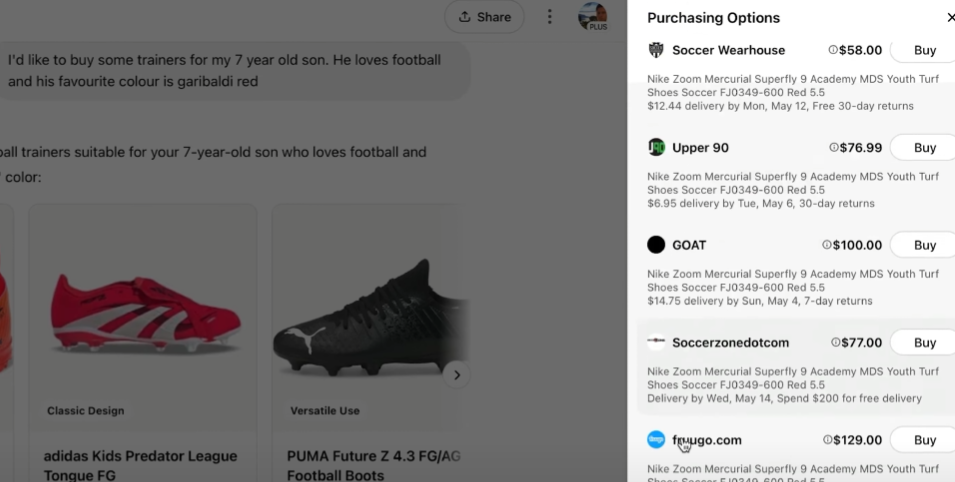ChatGPT now conducts 1 billion web searches per week, and within some of these searches, it is starting to recommend products. While not all users are enthusiastic about this development, marketers recognize the opportunity it presents. It is essential to understand how this system works and, more importantly, how to have products and services recommended.

In certain product categories, such as fashion and beauty, ChatGPT displays product tiles within the search results. Clicking on a product tile reveals a list of retailers offering the product, along with additional product breakdowns.
Despite its promise, the system is not flawless. For instance, prices shown may not always match those available from listed retailers. Users can ask follow-up questions for more details, demonstrating the potential for ChatGPT to function as a personal shopping assistant.
How the Product Listings Operate
The experience is product-first, then retailer. Initially, a list of products is presented, and only upon selection does a list of retailers appear. This differs from paid Google Shopping ads, which combine product and retailer in the same step.
| ChatGPT Shopping | Google Shopping Ads |
|---|---|
| Product ➔ Retailers | Product + Retailer together |
| Organic-style listings | Paid placements |
ChatGPT appears to pull product feeds, though the exact sources remain undisclosed. A likely scenario involves integration with Microsoft Bing shopping feeds, and potentially Shopify data, given existing partnerships in similar AI shopping tools.
Beyond Feeds: The Role of Online Conversation
ChatGPT does more than aggregate product feeds; it researches products extensively. For instance, in a search for the "best slim but rugged iPad Air Case," product recommendations cite discussions from non-ecommerce sites, such as Reddit, alongside traditional media.
Mentions and positive coverage of products on high-authority websites and user-generated content platforms increase the likelihood of being recommended. This practice is expected to continue as AI tools perform more comprehensive research across the web.
Strategies to Increase Product Visibility in ChatGPT
At present, ChatGPT relies on third-party product feeds, but is exploring direct product submissions from merchants. Merchants can register their interest to have products featured as this capability becomes available.
Providing comprehensive product information and utilizing schema markup for reviews ensures that crawlers can accurately interpret review snippets. Proprietary products should be promoted across the internet to become synonymous with target market positions.
Some publishers maintain relationships with OpenAI, resulting in frequent references to their articles. Gaining exposure in these publications can further increase the chances of being featured in ChatGPT shopping results.
The Importance of Online Sentiment and Product Reviews
ChatGPT emphasizes recommending the best products, making it essential to cultivate positive reviews across various platforms. For resellers, competition is heightened, often resulting in price wars. However, factors such as shipping costs influence purchasing decisions, not just the lowest price.
There is limited retailer-specific information within ChatGPT’s listings, so differentiating factors outside of price are minimal. Marketers must analyze the sentiment AI tools hold about brands and products, positioning offerings to be favored in AI-driven recommendations.
Tools like Profound provide sentiment analysis, revealing how AI platforms perceive brands. For example, if a brand is associated with "low fees," this can become a compelling reason for ChatGPT to recommend its products in relevant searches.
The Changing Buyer Journey and the Data Challenge
ChatGPT aims to compress the buyer journey so that research and purchasing decisions occur within the conversation box, reducing the need to visit multiple websites. This presents a challenge for retailers, as visibility into customer behavior and data analytics diminishes.
As a result, more marketing investment will shift towards
generative engine optimization (GEO) or answer engine optimization (AEO)—the practice of influencing AI tools to recommend specific brands or products.Adapting to the New Model: Winners and Losers
Brands must clearly define what distinguishes their products, optimize website content for AI readability, and foster widespread discussion about their offerings across user-generated and high-profile authority sites.
Only a select number of products and merchants appear in ChatGPT recommendations. This shift will result in some brands thriving while others may be left behind, echoing the disruption caused by the rise of Google in the past.
This new landscape necessitates strategic adaptation, as the gap between the winners and losers of AI-driven product recommendations is expected to widen.
